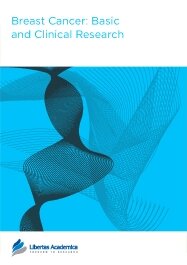

Publication Date: 06 Dec 2011
Type: Original Research
Journal: Breast Cancer: Basic and Clinical Research
Citation: Breast Cancer: Basic and Clinical Research 2012:6 1-8
doi: 10.4137/BCBCR.S8323

Background: Recent studies have shown that androgen displays an inhibitory effect on breast cancer cell lines that express androgen receptor (AR) but not estrogen receptor (ER) and progesterone receptor (PR). We have previously reported that approximately 1/3 of ER negative high grade invasive ductal carcinomas express AR. Thus, AR can serve as a potential therapeutic target for this group of patients.
Aim: Here we investigated AR expression patterns in 980 consecutive breast carcinomas.
Results: We found that (1) AR was expressed more frequently (77%) than ER (61%) and PR (60%) in breast carcinomas; (2) AR expression was associated with ER and PR expression (P < 0.0001), small tumor size (P = 0.0324) and lower Ki-67 expression (P = 0.0013); (3) AR expression was found in 65% of ER negative tumors; (4) AR expression was associated with PR and Ki-67 in ER negative tumors, but not in ER positive tumors; (5) AR expression was higher in ER positive subtypes (Luminal A, Luminal B and Luminal HER2 subtypes, 80%–86%) and lower in ER negative subtypes [HER2, triple negative (TN), and TN EFGR positive subtypes; 52%–66%], with over 50% of TN tumors expressing AR.
Conclusion: More breast carcinomas express AR than ER and PR, including significant numbers of ER negative and TN tumors, for which AR could serve as a potential therapeutic target.
PDF (2.02 MB PDF FORMAT)
RIS citation (ENDNOTE, REFERENCE MANAGER, PROCITE, REFWORKS)
BibTex citation (BIBDESK, LATEX)
XML
PMC HTML

We are delighted about the speedy and professional process.
Facebook Google+ Twitter
Pinterest Tumblr YouTube